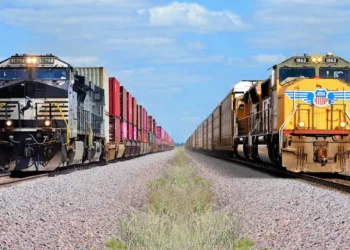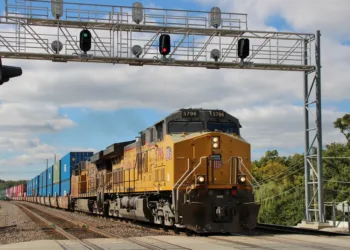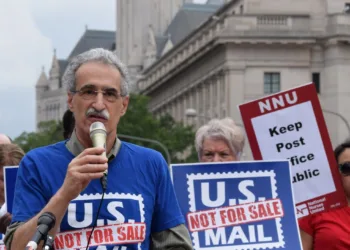
Scott Cornell, Vice President of Transportation at Travelers Insurance, sat down with FreightWaves’ Thomas Wasson on the August 4th episode of What the Truck?!? to discuss the evolving landscape of cargo theft that continues to plague the freight industry.
According to CargoNet data, cargo theft went up 93 percent between 2022 and 2024, while strategic theft in particular rose by 1475 percent.
Strategic theft, which involves deception or trickery, is the most difficult and most complex type of cargo theft for the industry to deal with, according to Cornell. Strategic theft tends to be done remotely through identity theft, double brokering scams and the use of phishing, phones, and other methods of communication to deceive or otherwise take possession of assets or information, while straight theft requires the criminal to be present.
“Since strategic theft can be done remotely or virtually, it has hit the industry pretty hard,” Cornell said.
Unfortunately, Cornell says, many companies have been so occupied responding to the massive rise in strategic theft that straight theft has taken a bit of a back seat.
“Cargo at rest is cargo at risk,” Cornell said.
When freight is sitting still, whether that’s at truck stops, parking lots, or drop lots, pilferage is a major issue.
“We say that pilferage is the iceberg below the water when it comes to theft,” Cornell said. “It’s the least reported, but one of the most frequent methods of theft.”
Pilferage usually involves a malicious actor cutting bolt seals, physically breaking into the rear of a trailer, and taking a pallet or two of cargo.
“We see plenty of cases where criminals will take an entire tractor or trailer, but pilferage is much more common and less reported,” Cornell said.
Strategic theft has gone from 5 percent to 33 percent of all theft, but straight theft still represents 67 percent of all cargo theft. Cornell says that there are some traditional hot spots for that theft, including southern California, Houston, Texas, and anywhere near inland ports like Chicago and Memphis where there are large railyards.
“In particular, the Arizona border of California has really become a hot spot for pilferage and follow crews over the past three to four years,” Cornell said. “Drivers are coming out of California with food and beverage, high end electronics, and a lot of them wait until they get into Arizona because fuel is much cheaper,” he said.
“Follow crews know that and will follow trucks to their stop or station members of their crews at popular stops, then wait for trucks to arrive,” Cornell said. “They will communicate to other crew members that a certain truck left a particular warehouse and target trucks with certain cargo.”
Simple security measures like cameras unfortunately are not enough to stop this type of crime.
“A lot of these crews are aware there may be cameras, and some facilities don’t have any cameras,” Cornell said.
Many drivers, Cornell says, also park outside of truck stop property when the lots are full, which leaves them even more vulnerable.
“There are actually more incidents where the outward-facing cameras from another truck catch theft in progress than there are where stationary cameras catch the crime,” Cornell said. “We call those popcorn reels. You can watch stuff get stolen but it doesn’t often lead to any information,” he said.
The vans and box trucks that these groups use are often unmarked plain white or other colored vehicles without a lot of identifying information, and they often have fake or stolen tags placed over the real tags.
“If you don’t happen to catch any real identifying information on a camera, you probably won’t get far with just a video,” Cornell said.
So, what should companies be doing right now to prevent these incidents?
“We work with our clients on a layered basis when we teach them prevention, and there’s three layers that we really work on,” Cornell explained. “That first layer includes good processes and procedures.”
The best procedures, according to Cornell, start with educating truck drivers.
“I think drivers are your best first line of defense,” Cornell said. “A driver who is made aware of risk factors and hot spots will be less likely to be taken unaware. Whether you can provide fuel incentives to help them reach safer areas or even just make them aware of dangerous areas and particularly risky types of freight, drivers can take extra precautions.”
Sometimes, for instance, a driver can back the trailer up against an obstacle so that the doors can’t be opened, while sometimes simply staying more alert and watching for suspicious activity can prevent theft.
“Secondly, you can use high-security rear door locks and make life more difficult for thieves,” Cornell said.
Air cuff locks, landing gear locks, and any other kind of hard security can act as a second layer of defense.
“Be a harder target,” Cornell said. “A lot of times, the driver is used to sleeping with the truck running and they’re accustomed to noise, so they won’t even hear or notice theft occurring. I don’t think people realize how difficult it can be for a driver to hear that something is going on at the back of their trailer.”
Lastly, companies need to be using technology to track and monitor cargo. Cameras inside the trailer can help increase the chances of identifying thieves and tracking down stolen cargo.
“We’re starting to see carriers who specialize in the secure movement of freight, because they’re responding to the increase in theft,” Cornell said. “They sometimes use modified trailers with reinforced doors, but there’s also other technology out there like Bluetooth locks that lock the door from the inside.”
Tracking has also come a long way, according to Cornell, but criminals have become more sophisticated in their efforts to avoid it. “A lot of bad guys are aware of tracking and can sniff it out with various devices, so you have to use a lot of redundancy,” Cornell said. “Place tracking devices in the trailer and in the cargo itself.”
Reporting any theft is another key step in preventing future crimes and in recovering stolen goods.
“For strategic theft, you need to report it to the law enforcement agency where control was taken of the load,” Cornell said. “Whether it’s identity theft or a double brokering scam, the location where the group took possession of the cargo is where you want to report the theft.”
“Always report to local law enforcement but be aware that some jurisdictions have a cargo theft task force,” Cornell said. “You need to make sure that you get your report to that task force. Florida, the Memphis area, and California Highway Patrol are some examples of regions with cargo theft task forces you can contact,” he said.
When it comes to instances of pilferage, losses can sometimes be more difficult to report.
“When they cut the seal, a lot of the crews will take the seal and put another same color seal on,” Cornell explained. “The driver completes their delivery, and all of the sudden everyone realizes there’s missing cargo. Where do you report that? It’s sometimes impossible to know where it happened.”
Law enforcement may be unable to help if the carrier can’t give them specifics.
Another difficulty comes with perishable goods, Cornell says. “Some food items are a loss whether or not they are recovered, as regulations may prevent them from being resold after the chain of custody has been broken,” he said.
To learn more about cargo theft data, visit cargonet.com.
Click here to learn more about Travelers Insurance.
The post With the increase of strategic cargo theft, don’t ignore straight theft appeared first on FreightWaves.





















